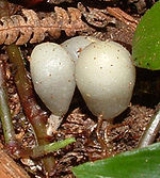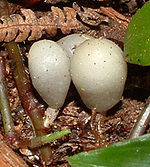
Secotioid
Encyclopedia

Hymenomycete
Hymenomycetes are the largest class of fungi within the phylum Basidiomycota. Many familiar fungi belong to this class, including bracket fungi and toadstools...
s and closed bag-shaped gasteromycetes
Gasteroid fungi
The gasteroid fungi are a group of fungi in the Basidiomycota. Species were formerly placed in the obsolete class Gasteromycetes Fr. , or the equally obsolete order Gasteromycetales Rea, because they produce their spores inside their basidiocarps rather than on an outer surface...
, where an evolutionary process of gasteromycetation has started but not run to completion. Secotioid fungi may or may not have opening caps, but in any case they lack the vertical geotropic orientation of the hymenophore
Hymenophore
A hymenophore refers to the hymenium-bearing structure of a fungal fruiting body. Hymenophores can be smooth surfaces, lamellae, folds, tubes, or teeth....
needed to allow the spores to be dispersed by wind, and the basidiospores are not forcibly discharged.
Explanation of secotioid development and gasteromycetation
Historically agarics and boletes (which bear their spores on a hymeniumHymenium
The hymenium is the tissue layer on the hymenophore of a fungal fruiting body where the cells develop into basidia or asci, which produce spores. In some species all of the cells of the hymenium develop into basidia or asci, while in others some cells develop into sterile cells called cystidia or...
of gills or tubes respectively) were classified quite separately from the gasteroid fungi
Gasteroid fungi
The gasteroid fungi are a group of fungi in the Basidiomycota. Species were formerly placed in the obsolete class Gasteromycetes Fr. , or the equally obsolete order Gasteromycetales Rea, because they produce their spores inside their basidiocarps rather than on an outer surface...
, such as puff-balls and truffles, of which the spores are formed in a large mass enclosed in an outer skin. However, in spite of this apparently very great difference in form, recent mycological research, both at microscopic and molecular level has shown that sometimes species of open mushrooms are much more closely related to particular species of gasteroid fungi than they are to each other. Fungi which do not open up to let their spores be dispersed in the air, but which show a clear morphological
Morphology (biology)
In biology, morphology is a branch of bioscience dealing with the study of the form and structure of organisms and their specific structural features....
relation to agarics or boletes, constitute an intermediate form and are called secotioid.
The word is derived from the name of the genus Secotium
Secotium
Secotium is a genus of fungi in the family Agaricaceae.The members of this genus are closely related to ordinary Agaricus mushrooms, but do not open out in the usual way; this has given rise to the term "secotioid" for such mushrooms in general...
, which contains such species.
On a microscopic scale, secotioid fungi do not expel their spores forcibly from the basidium and so the spores are statismospores. Like gasteroid fungi, secotioid ones rely on animals such as rodents or insects to distribute their spores.
It seems that sometimes it can be disadvantageous for a mushroom to open up and free its spores in the usual way. If this development is aborted, a secotioid form arises, perhaps to be followed eventually by an evolutionary progression to a fully gasteroid form. This type of progression is called gasteromycetation and seems to have happened several times independently starting from various genera of "normal" mushrooms. This means that the secotioid and also the gasteroid fungi are polyphyletic. According to the paper by Thiers, in certain climates and certain seasons, it may be an advantage to remain closed because moisture can be conserved in that way.
There is a spectrum of secotioid species ranging from the open form to the closed form in the following respects:
- there may be an evident stipe, or there may be only a remnant consisting of a column of non-fertile tissue,
- if there is a stipe the edge of the cap may separate from it (partially opening), or may not,
- there may be recognizable gills (though oriented in all directions and very convoluted), or the fertile interior may be uniform like the glebaGlebaGleba is the fleshy spore-bearing inner mass of fungi such as the puffball or stinkhorn.The gleba is a solid mass of spores, generated within an enclosed area within the sporocarp. The continuous maturity of the sporogenous cells leave the spores behind as a powdery mass that can be easily blown away...
of gasteroid fungi, and - the spore-bearing tissue may be above ground (epigeous), or underground (hypogeous), or partly buried.
The adjective "sequestrate" is sometimes used as a general term to mean "either secotioid or gasteroid".
Examples
For example, the secotioid genus HymenogasterHymenogaster
Hymenogaster is a genus of fungi in the Hymenogastraceae family. The genus has a widespread distribution, especially in temperate regions, and contains about 100 species. The taxonomy of the European species has recently been revised, and twelve species were recognized, for which an identification...
has been shown to be closely related to agaric genera such as Hebeloma
Hebeloma
Hebeloma is a genus of fungi. Found worldwide, it contains the poison pie or fairy cakes and the ghoul fungus Hebeloma is a genus of fungi. Found worldwide, it contains the poison pie or fairy cakes (Hebeloma crustuliniforme) and the ghoul fungus Hebeloma is a genus of fungi. Found worldwide, it...
, which were formerly placed in family Cortinariaceae
Cortinariaceae
The Cortinariaceae are a large family of gilled mushrooms found worldwide, containing over 2100 species. The family takes its name from its largest genus, the varied species of the genus Cortinarius...
or Strophariaceae
Strophariaceae
The Strophariaceae are a family of fungi in the order Agaricales. The family contains 18 genera and 1316 species. The species of Strophariaceae have a red-brown to dark brown spore print, while the spores themselves are smooth and have an apical germ pore. These agarics are also characterized by...
. This is found by DNA analysis and also indicated on a microscopic scale by the resemblance of the spores and basidia. According to a current classification system, Hebeloma now belongs to family Hymenogastraceae
Hymenogastraceae
The Hymenogastraceae is a family of fungi in the Agaricales.The blue-staining members of the genus Psilocybe form a clade that is sister to Galerina in the Hymenogastraceae; however, they have not yet been formally transferred....
, and is considered more narrowly related to the closed Hymenogaster
Hymenogaster
Hymenogaster is a genus of fungi in the Hymenogastraceae family. The genus has a widespread distribution, especially in temperate regions, and contains about 100 species. The taxonomy of the European species has recently been revised, and twelve species were recognized, for which an identification...
fungi than, for instance, to the ordinary mushrooms in genus Cortinarius
Cortinarius
Cortinarius is a genus of mushrooms. It is suspected to be the largest genus of agarics, containing over 2000 different species and found worldwide. A common feature among all species in the genus Cortinarius is that young specimens have a cortina between the cap and the stem, hence the name,...
.
A similar case is the well-known "Deceiver" mushroom Laccaria laccata
Laccaria laccata
Laccaria laccata, commonly known as the deceiver, or waxy laccaria, is a white-spored species of small edible mushroom found throughout North America and Europe. It is a highly variable mushroom , and can look quite washed out, colorless and drab, but when younger it often assumes red, pinkish...
which is now classified in the Hydnangiaceae
Hydnangiaceae
The Hydnangiaceae are a family of fungi in the order of mushrooms known as the Agaricales. Widespread in temperate and tropical regions throughout the world, the family contains approximately 30 species amongst 4 genera...
, Hydnangium being a gastroid genus.
Cortinarius
Cortinarius
Cortinarius is a genus of mushrooms. It is suspected to be the largest genus of agarics, containing over 2000 different species and found worldwide. A common feature among all species in the genus Cortinarius is that young specimens have a cortina between the cap and the stem, hence the name,...
is a very widespread genus of agarics, but also contains some secotioid species, such as C. leucocephalus, C. coneae and C. cartilagineus.
Secotioid genus Nivatogastrium corresponds to agaric genus Pholiota
Pholiota
Pholiota is a genus of small to fleshy mushrooms in the family Strophariaceae. The genus has a widespread distribution, especially in temperate regions, and contains about 150 species....
and provides a vivid example of the phenomenon.
It has been found that a change in a single locus of a gene of the gilled mushroom Lentinus tigrinus
Lentinus tigrinus
Lentinus tigrinus is a mushroom in the Polyporaceae family.- External links :* at Index Fungorum...
causes it to have a closed fruiting body. This suggests that the emergence of a secotioid species may not require many mutations.
Gastroboletus
Gastroboletus
Gastroboletus is a genus of fungi in the family Boletaceae. Species in the genus have misshapen caps, poorly developed or absent stipes, and are often buried or partially buried. Gastroboletus has tubes arranged irregularly, rather than vertically as in typical boletes...
is a secotioid bolete
Bolete
A bolete is a type of fungal fruiting body characterized by the presence of a pileus that is clearly differentiated from the stipe, with a spongy surface of pores on the underside of the pileus...
genus where the fruiting bodies may or may not open, but in any case the tubes are not aligned vertically as in a true bolete.
Agaricus deserticola is a secotioid species of Agaricus
Agaricus
Agaricus is a large and important genus of mushrooms containing both edible and poisonous species, with possibly over 300 members worldwide...
(the genus of common cultivated mushrooms) which at one time was placed in the genus Secotium. Similarly, Agaricus inapertus
Agaricus inapertus
Agaricus inapertus is a species of secotioid fungus in the genus Agaricus. It was first described by American mycologists Rolf Singer and Alexander H. Smith in 1958 as Endoptychum depressum. Molecular analysis later proved it to be aligned with Agaricus, and it was formally transferred in a 2003...
was formerly known as Endoptychum depressum until molecular analysis revealed it to be closely aligned with Agaricus.

